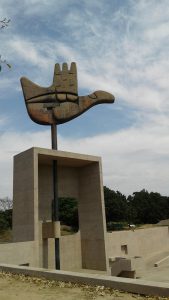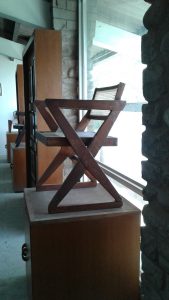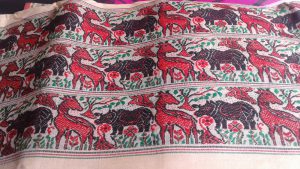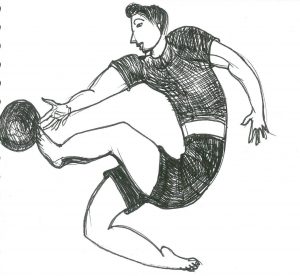At that point, I had already written THE WALLED CITY and was in Mumbai, so I went to meet the famed poet Nissim Ezekiel, who also happens to be a Bene Israel Jew and we were related from my maternal side.
Not only a poet, he was an art critic and was my role model, where it came to his poetry and truthful criticism, when he reviewed art exhibitions and his opinions mattered to both artists and readers. I like the last part of his Latter-Day Psalms, “All that fuss about faith, all those decisions to praise God, the repeated appeals, denunciations, laments and hopes, the division of men into virtuous and wicked! How boring and pathetic, but also how elemental, how spiritual the language, how fiery and human in the folly of its feelings! The images are beautiful birds and colourful fish: they fly, they swim in my Jewish consciousness. God is a presence here and the people are real. I see their sins. I hear His anger. Now I am through with the Psalms; they are part of my flesh.” Besides Nissim Ezekiel, there were few Indian Jewish authors.
Earlier, he used to encourage me; both as an artist and an art critic. Hesitantly, I gave him, the manuscript of THE WALLED CITY and asked for his opinion. Few months later, I received a postcard from him, saying,”…your writing is a formidable work of literary art.” Elated, I sent the manuscript to many publishers and when the book was published, I wanted Nissim Ezekiel to launch it, but unfortunately, he was unwell. I was distressed, but went through with the launch, on my own; in Ahmedabad. My narrative was simple and had abstract undertones of my conflicts. Suddenly, I was in the literary world.
Before I turned to words, in between I had turned towards art activism and worked in the area of art for development. Because, I had noticed that the sweeper’s son made dolls and masks from objects he picked from the garbage bin. That was the time, I started thinking about natural artists and started wondering and questioning whether it was possible to be creative without formal education? I came to the conclusion; that spontaneous images of untrained artists were exciting, original and intense. Perhaps this questioning had started, when as a child, I realized that Mani, who had looked after me, along with my grandmother was a natural story teller. Later, I was to meet many more such natural artists. Eventually when I took to writing, all these characters found a place in my novels and short stories, BY THE SABARMATI.
By then, I had decided to restrict myself only to literature. It gives me the space and freedom I have always been looking for.
Literature allows me to expand in all directions. It gives me a limitless space for creation. Writing allows me to journey across an entire landscape of experiences.
When I started writing my first novel THE WALLED CITY, it liberated me. Writing satisfies me. My expression comes through at its fullest through words which create forms and images.
It does not resist me. It allows me to flow and grow. It gives me a flexibility of expression.
In “The Walled City,” the walls were symbolic of city, community, family and even womanhood. I tend to set all my work around women and Ahmedabad. I use the city like a stage. This is the beginning of my first novel – “I was born in the walled city of the fourteen gates. Walls on which the black-faced langurs with their flag like tails sit like sentinels, daring me to break the line of their gray bodies – or- The house is like a Banyan tree. To reach it, one must turn to the right from Dilli darwaza-it is said, a Moghul emperor had returned to Delhi, royally piqued because the umbrella of his elephant had grazed the the arch over the gate – continue past the shops selling mattresses and then squeeze between the garage for the family victoria and the Syed family’s three-storied house, where there are more goats and chickens than people and where the air is always thick with the strange smell of goat droppings and jui flowers. Or Jerusalem with the golden stones. Eyes swimming like fishes in the turquoise Sea of Galilee…skins mingling, mixing, changing colour. Graves on the shores of Navgaon. Six couples crouching in the womb of the earth.”
Once the editing of a novel is completed, I remain involved with the cover and almost all the characters of my novels are often created in my sketch books. These later transform into illustrations for my novels.
Like the description of Sulemanbhai – “In the morning sun, Sulemanbhai’s hennaed hair with its yellow streaks matches the colour of the roses. Swept backwards without a parting, it contrasts with the white beard bristling under the paan-stained buck teeth. The effect is startling. His brown eyes shine like a hyena’s or this description – Aunty Jerusha stands in the doorway, wrapped in a blue silk kimono with a red dragon running across it. Her face is plastered with powder like a geisha’s and one of her moth eaten French scarves adorn her balding scalp. Though it is the height of summer, she is wearing her ancient fur tufted bedroom slippers with the made in England tags still hanging from the corners.”
With the launch of THE WALLED CITY and the response it received, I started working around the genre of Indo-Jewish literature.
Till then, I did not understand; what it meant to be a practicing Jew, as ours was a secular family. Whatever I had learnt; was from my grandmother, the rituals and traditions she followed; when we lived as a joint family or when she took us to the Synagogue.
Research about the intricacies of Jewish life, started with BOOK OF ESTHER.
Let me clarify, today, I have a better understanding of Jewish life, but I am not religious.
Much later, my passion for the old city of Ahmedabad, where I spent my childhood was published as AHMEDABAD:CITY WITH A PAST.
The Walled city, which has been translated into French, Gujarati and Marathi, brought in much of the imagery that I had earlier practiced as a visual artist and received critical acclaim. It was a story of three generations of Bene Israel Jewish women living in the city of Ahmedabad, India. The book was translated into French by Sonia Terangle titled LA VILLE EN SES MURS, and published by Editions Philippe Picquier, France. It was shortlisted for the Premier Liste de Prix Femina in France. In Gujarati, it was translated by Renuka Sheth and in Marathi; it was translated by late Gauri Deshpande and then Ambika Sarkar.
The Walled City was republished by Syracuse University Press; USA in 2002. Later, it was repbulished by Westland Books in 2009 and is now available as an EBook. Irene Vilar-Cuperman, acquisitions editor, Syracuse University press, New York, wrote, “I am halfway through The Walled City and don’t have enough words to describe my enchantment with it! My admiration goes out to you. Your literary voice is endearing, truthful and powerful. I truly love The Walled City and will make sure that it is read and read and read.”
I would like to say a few words about Gauri Deshpande, I met her at a conference and she offered to translate THE WALLED CITY in Marathi. Late Gauri Deshpande was a well known writer and translator, known for her bold themes and innovative writing in Marathi. She had published poems, essays and short stories in English as well and known for her translation of the sixteen volumes of Sir. Richard Burton’s The Arabian nights is considered a landmark event in Marathi publishing history. She was also teaching post graduate courses in English Literature at the University of Poona.
I like her short stories, in ROSE JAM, she wrote, “I was not crazy about being put to work in my holidays, specially not on rose jam. One had to get up very early, while the dew was still on the flowers. The flowers had to belong to only one variety of rose, the very thorny indigenous, deep pink, heavily fragrant one with fleshy petals. My father, an enthusiastic gardener in his spare time, had planted a few of these rose bushes in our garden. So we would be hauled out of bed, made to wash and sent off with baskets to bring in the heavily scent laden roses, only the fully open ones, without spilling too much of the dew. Aai would then separate the petals and lay them in a thick layer at the bottom of a stout glass jar with a wide mouth. On top of this layer she would lay rock candy, roughly pounded and mixed with a bit of colloidal coral. Then she would cover this jar with another layer of rose petals, and another of sugar mixture, until the jar was full. Then she would put it on the roof where it would catch the fierce summer sun and slowly cook itself and settle into a sticky jam at the bottom of the jar. The next day she would send us off for more roses and begin another layer. This would go on until the jam had no further to settle and the jar was full…I am certain it is only on account of this wonderful remedy that I never had heat stroke, sunburn, headache or nosebleed throughout those out of doors summers.”
While in “By the Sabarmati,” I tried to give a voice to the women I had known, as they lived in hutments in under-privileged areas of Ahmedabad, when Pushpa narrates – “ I hated my veil, as I could never lift it and see things properly, and it always enveloped me in a haze. So, I entertained myself by using the colour of my sari as a transparent glass. When I looked through it, everything in my world was tinted with different colours. It was a game I played with myself. Sometimes green fields appeared orange, the moon looked purple and the sun could be either gray, brown or black. Even faces changed colour like a rainbow, The face that never changed colour was that of my mother, it was always there in a flood of white tears.”
These are three women I worked with in the beginning and their works were exhibited at Unesco, Paris to much acclaim. In France, I was invited by Unesco to show the work of Natural artists in an exhibition titled – IN THE STREET, JUST ACROSS MY HOUSE.
Pushpa started earning well by transferring her paintings into patch work, with this money she bought two sewing machines and has since returned to her village. Her forays in the art world have strengthened her, she no longer covers her face, leant to read and write and was respected in her society as Mastrani. I refer to this work as Action through Art. Her story, inspired me to write a collection of short stories, which were published by Penguin India titled BY THE SABARMATI. She was the inspiration behind stories of people I had known, some of whom were natural artists. The stories are in their own voices. I have therefore placed myself in the circle of their experience, which I have tried to understand in the first person, which could be my story – your story. I wrote about Pushpa in these words – “ I hated my veil, as I could never lift it and see things properly, and it always enveloped me in a haze. So, I entertained myself by using the colour of my sari as a transparent glass. When I looked through it, everything in my world was tinted with different colours. It was a game I played with myself. Sometimes green fields appeared orange, the moon looked purple and the sun could be either gray, brown or black. Even faces changed colour like a rainbow, The face that never changed colour was that of my mother, it was always there in a flood of white tears.”
In my novels, I mingle fact and fiction and create my own world. But, everything changed, when I discovered Alibaug on the Konkan coast, the Indian homeland of Bene Israel Jews. Slowly, I became better informed about the Jewish experience in India, collecting family histories, documenting, Jewish life styles, costumes, Synagogues, cuisine and artifacts.
Then, I was commissioned to write Book of Esther by Penguin Books. As I sat among the old photographs, I saw the remains of our old family house at Delhi Darwaza, I started weaving stories based on research and memory, as it slowly transformed into one single narrative.
Book of Esther is part fiction, part reality.
I am named after Queen Esther, who helped liberate the Jews of Persia and finds mention in the Megillat, known as The Book of Esther in the Bible, so I used it as a base for my novel.
It is also based largely around my family.
Being the only child of working parents, I was often left with my grandmother in the ancestral house where she stayed with my uncle and his family. It was here in the Delhi Darwaza house, where relatives visited us during vacations and sometimes stayed on for long periods, where I heard family stories. That was before their exodus to Israel, England, America and Canada. Yet, the house remained the main satellite, which received many stories, through letters, telephonic talks or just nostalgia on part of those who were left behind. The elders departed to RIP and the others started losing contact. And, I spent long hours with a large collection of photographs and stories. This became the fertile ground for THE BOOK OF ESTHER.
Soon after, On the initiative of Dr. Shalva Weil of Jerusalem University, I wrote a small article for Marg about Jewish costumes, “Sari-Sutra.” This study helped me in the description of my characters.
That was also the time, after the death of my father. Suddenly, I needed the comfort of the large extended family I had lost. Some characters, which took shape there, have found their way in the latter part of Book of Esther.
For me, these ancestors are real. Sometimes I am a bird from the tree, sometimes as blind as a bat. I feel their presence around me. Sometimes they bind me, sometimes they comfort me.
And Shalva Weil wrote in her book KARMIC PASSAGES, “The Bene Israel novelist who grew up with a tiger.”
During this period, my editor Mala Dayal, felt the story of growing up in a zoo, could take the form of a book, for people of all ages and I wrote MY FATHERS ZOO. And, Khushwant Singh wrote,” When Steve Irwin, the famous crocodile hunter was killed by a sting Ray in September, last year, I had concluded that only Australia produced daredevils who could capture dangerous animals like crocodiles, alligators and venomous snakes with their bare hands. I was wrong. Many Indians have been doing so down the generations and do so to this day. Among the most famous was Reuben David of Ahmedabad. He not only captured crocodiles and snakes but also tigers, lions, langoors, bears and a variety of birds in his home and the zoo he set up. He formulated his own herbal medicines to keep his friends in good shape. His life story has been written by his daughter Esther David. Her line drawings illustrate how close he was to birds and beasts :he had been living with them. He sat by a female crocodile while she was laying her eggs and helped her to incubate them. It is a true life story of how harmonious human-animal relationships can be, any person who gives his love to an animal or bird will have it returned in full measure. The book is specially meant for teenagers but makes an equally fascinating read for grown-ups. “
With the launch of BOOK OF ESTHER, I received emails and letters from a Pakistani journalist about a certain Aunty Rachel, who lived in Karachi and protected the cemetery there as the Synagogue had been destroyed. She was a Bene Israel Jew, a school teacher and spoke fluent English, Hindi, Marathi and Gujarati. When, she was very old, with help from the American embassy, she was flown to Israel, where she died and the cemetery was taken over by others. BOOK OF RACHEL took shape, while writing Book of Esther. I had discovered in Alibaug, where the Bene Israel Jews had first landed, that their food was similar to the food; my grandmother used to make, Somehow, these fragrances came back to me, and I included them in BOOK OF RACHEL, starting each chapter with an old Jewish recipe, which we rarely make today. This is how Rachel became realty, as she preserves the heritage of Synagogues and food. And, I started each chapter of BOOK OF RACHEL with a recipe, as Rachel struggles to save a Synagogue from land-sharks. In continuation, another publisher suggested, I write Jewish short stories, I agreed, but, while working on this collection, I set the characters in a housing society, confronting the various social problems and cross cultural conflicts faced by such a small community. In India, Jews are surrounded by so many attractions and yet trying to preserve the Jewish heritage. This is how SHALOM INDIA HOUSING SOCIETY was created and became a novel. The protagonist of this novel is Prophet Elijah, whom I discovered in Alibaug. In a way, SHALOM INDIA HOUSING SOCIETY happened because of Book of Rachel, in which the Prophet Elijah is the main character. So, I decided to weave SHALOM INDIA HOUSING SOCIETY around the Prophet, as for us Bene Israel Jews, Prophet Elijah is more than real. About the housing society, in the past, I had seen Jews living together in Jacob Circle in Bombay. More recently, there is a similar housing society, in Thane near Bombay. SHALOM INDIA HOUSING SOCIETY is set in Ahmedabad after the communal riots of 2002. The storyline weaves the lives of its residents and their inter-cultural relationships with other Indian communities. They are also caught in their longing for The Promised Land, Israel, as today, most families live in divided homelands. This novel also deals with other sensitive issues like conversion and how the young are attracted towards people of other communities. To write about these concerns, I visited the homes of Bene Israel Jews, interacted with them and got a better insight into their lifestyles. The novel traces conflicts between parents, children, lovers and neighbours with occasional interventions by the Prophet Elijah, to whom the characters turn to in times of trouble.
Bene Israel Jews believe in the Prophet and believe, on his way to heaven, Prophet Eliaj passed through India, Alibaug on the Konkan coast and left a mark of the hoof marks of his horses and chariot wheels on a rock. So, Bene Israel Jews start all events as a thanksgiving to the Prophet and ask him to fulfill some wishes and once done, that particular person or family, holds a Malida ceremony and feeds the entire community.
So, in my novel SHALOM INDIA HOUSING SOCIETY, the Prophet visits Jewish homes, during the festival of Passover, all over the world. During a certain prayer, a chair is kept aside for him, and he is offered a goblet of wine, which is kept aside for him. I loved this concept and belief and enjoyed writing how, sometimes he helped people or was even mischievous in creating problems for others. In Gujarat, he is offered black currant sherbet. Indian Jewish life has many Indian influences, like the Malida made with a offering of flaked rice or poha mixed with sugar and coconut, dates, petals of desi red roses, apples and bananas, even a Mehendi or Henna ceremony is held before a wedding in Indian clothes, garbas have been recently included, but during a wedding bride and groom wear western clothes. SHALOM INDIA HOUSING SOCIETY gave me a place in the calendar of Hadassah-Brandeis University, U.S.A. in 2010-2011; as one of the twelve best-known Jewish women authors of the world. Soon after, they gave me the opportunity to research and document Bene Israel Jews of Gujarat; titled, “I AM ASEED OF THE TREE,” which has been published by India International Center as a journal. Today, I am documenting the cuisine of Indian Jews. Besides Bene Israel Jews, there are Cochin Jews, Baghdadi Jews of Kolkatta, Bene Ephraim Jews of Andhra Pradesh and Bene Menashe Jews of Mizoram.
My novels are researched by many other scholars in India and abroad, like Elizabeth Chalier-Visuvalingam of the The Art Institute of Chicago and the French International School of Chicago, USA., has written, “Esther David belongs to the Bene Israel Jewish community of India. Her book ‘The Walled City,’ translated into French as ‘La Ville en ses Murs,’, may in fact be a metaphor for her hometown, India, but it also seems to us, for Jerusalem and can also be another perspective, a metaphor for any mental confinement. This book is followed by Book of Esther and Book of Rachel, which tell the story of Esther David, but also her community, the Bene Israel, which share many values with the Indians but also with the Jews. The pages of this book illustrate the difficulty of the journey through otherness, the impossible detachment of man and his territory, the complexity of envisaging our destiny otherwise.”
Let me explain, although I like to read Jewish authors, I read novels, which are not based on Jewish subjects. I have been inspired by authors like Rabindranath Tagore, Alexandre Dumas, R.K.Narayan, Gabriel Garcia Marquez, Salman Rushdie, Toni Morrison, Nadine Gordimer, Margeurite Duras, Orhan Pamuk, Amy Tan, Isabel Allende, Graham Greene, Laura Esquivel, Iravati Karve, Ismat Chugtai, Rohinton Mistry and Arun Joshi. I am fascinated by Arun Joshi’s novel, The Strange Case of Billy Biswas. It is one of my old favorites.
I had bought it in the seventies from a bookshop at the railway station. Often I turn to this book as it is all about freedom of the human spirit. Recently, it has been republished with a new cover, as a good work of literature survives time. The entire gist of the book is narrated in the first page “As I grow old, I realize that the most futile cry of man is his wish to be understood. The effort to understand is even more futile. If in spite of this I propose to relate Billy’s story, it is not because I claim to have understood him, as it is on account of a deep and unrelieved sense of wonder that in the middle of the twentieth century, in the heart of Delhi’s smart society, there should have lived a man of such extraordinary obsessions.” Arun Joshi ends the novel with this strong statement, “The strange case of Billy Biswas had at last been disposed off in the only manner that a humdrum society knows of disposing its rebels, its seers, its true lovers.”
Through the years, Art became a way of life, while literature is my life.
Because, inside me, there was a sea of stories, but as a sculptor I was locked in a block of wood.
My novels are MY JEWISH VOICE…because; I had a dream; I wanted to recreate my experience of being an Indian Jew, through my novels.



